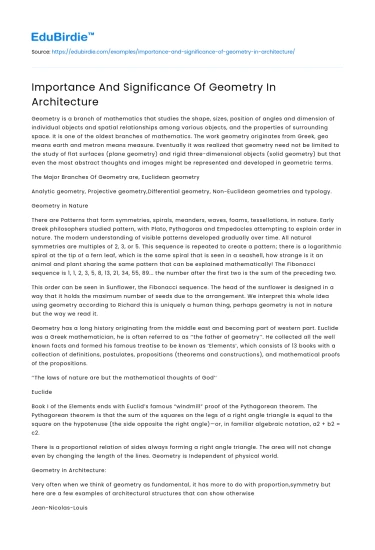Geometry is a branch of mathematics that studies the shape, sizes, position of angles and dimension of individual objects and spatial relationships among various objects, and the properties of surrounding space. It is one of the oldest branches of mathematics. The work geometry originates from Greek, geo means earth and metron means measure. Eventually it was realized that geometry need not be limited to the study of flat surfaces (plane geometry) and rigid three-dimensional objects (solid geometry) but that even the most abstract thoughts and images might be represented and developed in geometric terms.
The Major Branches Of Geometry are, Euclidean geometry
Save your time!
We can take care of your essay
- Proper editing and formatting
- Free revision, title page, and bibliography
- Flexible prices and money-back guarantee
Analytic geometry, Projective geometry,Differential geometry, Non-Euclidean geometries and typology.
Geometry in Nature
There are Patterns that form symmetries, spirals, meanders, waves, foams, tessellations, in nature. Early Greek philosophers studied pattern, with Plato, Pythagoras and Empedocles attempting to explain order in nature. The modern understanding of visible patterns developed gradually over time. All natural symmetries are multiples of 2, 3, or 5. This sequence is repeated to create a pattern; there is a logarithmic spiral at the tip of a fern leaf, which is the same spiral that is seen in a seashell, how strange is it an animal and plant sharing the same pattern that can be explained mathematically! The Fibonacci sequence is 1, 1, 2, 3, 5, 8, 13, 21, 34, 55, 89... the number after the first two is the sum of the preceding two.
This order can be seen in Sunflower, the Fibonacci sequence. The head of the sunflower is designed in a way that it holds the maximum number of seeds due to the arrangement. We interpret this whole idea using geometry according to Richard this is uniquely a human thing, perhaps geometry is not in nature but the way we read it.
Geometry has a long history originating from the middle east and becoming part of western part. Euclide was a Greek mathematician, he is often referred to as ‘’the father of geometry’’. He collected all the well known facts and formed his famous treatise to be known as ’Elements’, which consists of 13 books with a collection of definitions, postulates, propositions (theorems and constructions), and mathematical proofs of the propositions.
‘’The laws of nature are but the mathematical thoughts of God’’
Euclide
Book I of the Elements ends with Euclid’s famous “windmill” proof of the Pythagorean theorem. The Pythagorean theorem is that the sum of the squares on the legs of a right angle triangle is equal to the square on the hypotenuse (the side opposite the right angle)—or, in familiar algebraic notation, a2 + b2 = c2.
There is a proportional relation of sides always forming a right angle triangle. The area will not change even by changing the length of the lines. Geometry is Independent of physical world.
Geometry in Architecture:
Very often when we think of geometry as fundamental, it has more to do with proportion,symmetry but here are a few examples of architectural structures that can show otherwise
Jean-Nicolas-Louis Durand, Lectures on Architecture (Précis des leçons d'architecture données à l'École Polytechnique) ,1802 27
Jean-Nicolas-Louis Durand was a 19th century french author, teacher and architect.
His system of design using simple modular elements anticipated modern industrialized building components. The plan above follows rigid grid, order or simple geometry.
Durand’s dominating criterion for architecture was however disposition which led him to the full dedication to functionalism. Durand’s rationalist principles gained codification into a systematic theory of architectural composition based on a grid system of horizontals and verticals generating infinite number of combinations of plans and elevations in terms of volumes according to the requirements of disposition.
Most of Hadids works and designs are known for there complexity flowing, curved style that eschews sharp angles. Her works are an exceptional example of geometry in the contemporary world.
Construction of building and geometry run in parallel. AF Frezier 1739 (stone cutting) is another example of it. Stone work in historic building- had to work out the shape of each stone to fit them so that they fit like a jigsaw. Therefore it is understood that geometry is perhaps not in the thing itself but in the process and also in the way in which geometry leads to a particular spatial concept or the way of thinking about what one is making.
Geometry in Interior
Two Example of interiors were shown in the lecture
Sant'Ignazio, Rome (17th century). Andrea Pozzo paints the dome and the Frescoes he used the technique of quadratura to create an illusion of three-dimensional space on flat surfaces. perspective painting was used to make it look something it is not. A Space created in a space, but it is all about standing on the right position to view what is intended to be seen
The dome doesn’t exist, it is flat surface the dome is created by drawing fake architectural work with column which gives a perspective illusion.
The Frescoes- here Andrea Pozzo creates an optical illusion that gives the impression of an infinite space. A world that opens up to beyond the physical church some heavenly world inhabited by angels.
Tesseact study- an idea that the physical world has other dimensions that extands out- ambiguous drawings- ability fluctate- logic behind simple- following logical pattern of everyday world- euclids geometry.
Formula for circle- based on pythagors theorm- x and y coordinates. There is a pattern. There is no W cordinate in real world we only have X and Y and z… W extends to an imaginarey plane- a world beyond the physical world. Mathematically 4 dimens can be created.






 Stuck on your essay?
Stuck on your essay?

